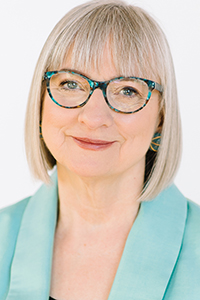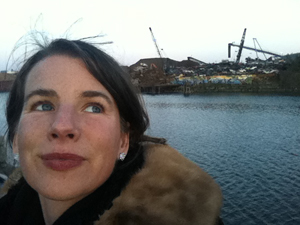Multifarious and Far Reaching:
Maleea Acker in Conversation
with Molly Peacock

Malahat creative nonfiction board member Maleea Acker talks with Open Season Award creative nonfiction judge Molly Peacock about the Canadian creative nonfiction scene, an author's shift in writing circuits, and female voices in the literary world.
Molly Peacock is a widely anthologized poet and biographer, the author of the best-selling The Paper Garden: Mrs. Delany Begins Her Life’s Work at 72 (named a Globe and Mail and an Economist Book of the Year) and Alphabetique: 26 Characteristic Fictions with illustrations by Kara Kosaka (both published by McClelland & Stewart/ Penguin Random House). Read the rest of her bio here.
What are you looking for in creative nonfiction contest submissions for the Malahat’s Open Season Awards? What makes your heart leap and your mind light up?
A fresh, authentic voice with some vulnerability and candor. A voice that doesn’t pretend it knows everything. A thought process both substantial and surprising. Subjects? Anything from the quietly personal to the devastatingly political. And always, arresting vocabulary.
Canadian creative nonfiction is multifarious and far reaching, as far as I can tell as an editorial board member at the Malahat; it moves from the domestic to the travel narrative, from urban to rural. Are there trends you see in current CNF that excite you? Are there places you feel it has not yet reached?
I’m excited by Canadian biography. Recent marvelous biographies I’ve read range from Sandra Djwa’s biography of P.K. Page, Journey with no Maps, to Ross King’s encompassing Group of Seven biography, Defiant Spirits, to Emily Urquhart’s memoir and investigative book about albinism, Beyond the Pale. These are all uniquely Canadian stories, beautifully researched, yet interpretive of lives. Is biography a trend? I’m not sure it’s a trend in essays, exactly, but portraiture is, the type of essay that peels back the layers of a person’s character. I find that fascinating. What places hasn’t Canadian CNF reached? I often feel there is a reluctance to be emotionally vulnerable in Canadian CNF, and that goes for factual, more political or sociological nonfiction as well as memoirs. Think how personal and tentative Montaigne is, the original essayist. We could use a little more whimsy and a little less ironic distance.
You’ve written some stunning accounts of creativity as experienced by women artists. And yet when we open many magazines and journals today, the field is still dominated by male writers. How do we ensure that women’s voices and women’s understanding of the creative life are heard and validated? What needs to be done to level the playing field, so to speak?
My first plea is for women to keep playing. Keeping out there, sending out, persisting, speaking, reviewing, is what levels a playing field. My second plea is for women to keep counting. Canadian Women in the Literary Arts (CWILA) and VIDA: Women in Literary Arts (US/UK) conduct yearly counts of how women are doing in terms of bylines in key journals and magazines. Seeing these sometimes appalling numbers raises awareness and embarrassment levels. Statistics speak with undeniable power. Tweeting and posting these figures is super important—and it really has an impact. It’s not just the count, but shouting the count that matters.
You’ve also written on your experience of artistic practice as a woman who has chosen not to have children. What advice would you give to women artists (and particularly women writers) who are beginning their careers and trying to do service to the creative life?
Perhaps this is really two different questions. I think you’re trying to get at how women juggle time. I would say this to younger women or anyone now emerging as a writer: Schedule your writing life. Put your writing time in the calendar as if it were a dentist’s appointment. You show up for your dentist, don’t you? So show up for yourself. When you block out those hours in the calendar, it’s suddenly a lot easier to tell people you’re busy during those times, or to sigh and say, Sorry, I’m working then—or to slot in childcare. Just as you’d get childcare so you can fix your teeth, get childcare so you can fix your sentences.
And as for the first part of your question: I chose the journey over the nest, but that doesn’t mean younger women must make such a choice to be an artist. Yet, interestingly, some do. This may have less to do with an artist’s life than with the calling to motherhood. For a little more about this, go to vimeo to see Renee McCormick’s documentary about a midwife, an athlete and a poet (me) who chose not to have children.
Because of Paradise, Piece by Piece, I’ve had an eighteen-year conversation about this subject, and through those candid letters, emails, TV programs and radio interviews, I am shocked (and delighted) to say that my memoir is now an e-book.
You began your career as a poet, but have moved in recent years more towards the essay genre. What drew you in that direction? What do the two genres offer that attract you in different ways? Can the essay do things that the poem cannot?
For me, the essay is about time; but the lyric poem is about space, or stopped time. Time and events unfold, and as I’ve aged, narrative and explanation seem as fascinating as the lyric moment. Deciphering lives—as I continually seek to make sense of my own—has become tremendously meaningful. The essay addresses this urge to decipher. But I am still drawn to the lyric moment, and in times of extreme emotion, poetry is a must.
What are you currently reading?
Lab Girl by Hope Jahren—it’s spectacular to hear a research scientist speak so memorably about her grant-driven scientific calling as well as to hear her on botany and the lives of plants. Just a few paragraphs on the life and death of a beloved spruce tree captured me as if I were ten years old again, reading The Secret Garden.
“Beirut Bombing” by Tanya Bellhumeur-Allat is a stellar example of the intersection of the personal and political by a woman who can make a shining metaphor, found in The Best Canadian Essays 2015. I’m also reading The Best Canadian Essays 2014 because it’s the only one of those anthologies that was guest edited by a woman, Natalie Zina Walschots. Yes, I’m counting!
To those who are considering submitting to the Open Season Awards, what advice would you give?
Don’t try to figure me out as a judge. I read widely. Just because I write about older women visual artists and flowers doesn’t mean you have to. (But if you are an older woman who does, don’t ignore this contest!) And if you are a person who feels your work is somehow unfashionable, please take a chance and submit. You never know…

Maleea Acker
* * * * * * * *









